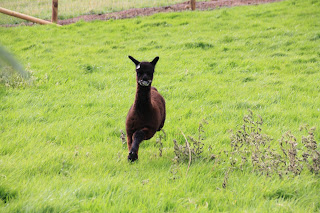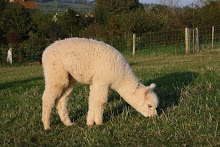We
were in the middle of a heatwave, a Tuesday - it was to be the third
day in succession with temperatures of at least 30 degrees.
Blossom's due date was three days earlier, and Elstar's due date was
on the coming Friday - both had raised cria last year.
When
I fed the nursery group in the morning, they all came to the troughs,
there was no unusual behaviour which might have suggested a birth to
come. But at 8.00am after feeding the rest of the herd over the hill,
and on my way back to the house to answer a call of nature, I saw two
feet coming out of Blossom, and ran to tell Joy who was cooking
breakfast for B & B guests. By the time I got back, a brown male
cria was on the ground, the rest of the herd had gathered around,
Blossom was standing by, and Elstar was sniffing and licking him.
I
stayed and watched and the rest of the herd drifted away. He was a
bit raspy, so we cleared mucus and membranes, but it didn't clear
completely, so I gave him a 'swing'. He was slow to sit and we helped
him to stand up, he was down on his pasterns, and didn't stay up for
long. The placenta was delivered swiftly, and appeared normal. Elstar
remained intrusive, and I told her that she had to wait, as hers
wasn't due until Friday (!), so we moved Blossom and her newborn into
a pen in the shade of some trees. It was as if Elstar thought he was
hers.
The
temperature was rising to the upper 20's, and as he wasn't showing
the usual urgency or energy to sit up, stand, and then walk, I didn't
go to work, but watched, and waited. After around three hours he
hadn't managed to feed - Joy checked Blossom's teats for milk, and
noticed that they were particularly large - she is a large-framed
girl - there was milk, so we put him under mum, but he didn't suck.
So we started thawing plasma and called the vet to check on his chest
and also administer the plasma. The vet was fairly happy that his
chest would clear with exercise, and gave the plasma by tube, orally
into his stomach. After allowing an hour and a half for that to
absorb, we gave him about 100ml of goats milk, and he was getting
more active, and searched under mum for her milk.
We
named him Jazz - we name all cria after an apple variety, and this
year we are on the letter 'J' - already having used Jupiter and
Jester - I went to work at 2.00.
After
a while, Joy allowed them out of the pen, and allowed the rest of the
group back into the paddock. Elstar went straight to him, and he went
straight to her, and went under her, so Joy separated them all again.
After separation, Elstar's behaviour indicated that she clearly would
have preferred to be with them in the next paddock.
He
became more active, and Blossom was attentive, he was less interested
in the goat's milk, so we were happy that progress was being made.
In
the evening, they had moved to the top of the hill, and I went to
take some photographs of Jazz - he was sitting in the long grass, and
I moved around him, taking pictures from different angles - as I
crouched for the fourth photo from a different angle, my heart sank
as, looking through the viewfinder, in the background beyond him I
saw, what I immediately knew was a dead cria..............and things
immediately fell into place - Elstar had given birth to a stillborn
during the night, and was grieving, and maybe thought Jazz was, or
could be, hers! It all started to make sense - she must have had it
very early during the night, we searched the long grass but didn't
find a placenta, and there was no blood staining her legs - because
our attention that morning was closer to home, and the shade of the
glade with the temperature reaching 32deg, we had no need to go up
there. Elstar came to feed with the others at breakfast time, so
there was no odd behaviour....except for her interest in Jazz after
his birth. There was nothing to suggest that she might have given
birth.
We
were naturally very disappointed - it was a solid brown male, a good
size, and would have been the first offspring of our stud male,
Fortune (since then, some lovely cria sired by him have been born to
females at other breeders).
We
immediately let them all get together, Elstar went to Jazz, Blossom
didn't mind, and when checked after dark, the three were sitting
together.
The
following morning, I went up the hill at 7.00am, and amazingly,
Elstar was feeding Jazz! It seemed like Elstar was using him to get
over her loss, and it appeared that Blossom understood and accepted
it! We offered him milk that night, but he wasn't interested. Our
neighbour baled our hay that night, so the following evening, with
the help of friends, we got the hay into the barn.
He
naturally lost weight in the first 24 hours, but the following day he
had gained a little, and he continued to gain 200-300 grams per day.
In the following days, we only saw him feeding from Elstar, though we
may have missed him feeding from Blossom, because on the 16th, 18th
and 19th days, I saw him feeding from Blossom. Blossom is a much
larger animal than Elstar, and we have wondered whether he found her
teats too large.
Generally,
all three moved around the paddock together, and would sit close.
When Elstar is feeding Jazz, Blossom's ears are back, as all breeders
will recognize, a sign of dissatisfaction with a situation, and the
sight was a little bit heart-wrenching as you wondered what she was
thinking - there have been times when Blossom would try to direct
Jazz to feed from her, using her nose, but he would wander away -
nevertheless, we have not seen any animosity between Elstar and
Blossom. At almost six weeks old, the threesome are still often
closer together than the rest of the herd, though not always, but
Jazz will always be near Elstar unless he is playing with the other
boys.
A
fascinating arrangement unfolded before us - on reflection, we felt
we handled the situation satisfactorily - had we known about the
still-birth earlier, we would have recognized what was happening, and
perhaps dealt with it differently, but we did separate them twice on
that first day - however, the choice was made as much by Jazz, as it
was by Elstar, and he has thrived. Elstar and Blossom have been
re-mated and we look forward to next year.
 |
| Apple Vale Jazz - dam: Apple Vale Elstar (sire: Van Diemen Qjori of Patou) sire: Wimmera Skies Class Act of Reddingvale |
With all this attention to Jazz, the birth of Jester to first-time mum Florina three days earlier became somewhat over-shadowed. Florina wasn't due to birth for three weeks, and when our son shouted', "there's a cria in the paddock!", we were surprised to see Florina proudly standing behind a wet black male cria.
Florina (sire: Van Diemen Qjori of Patou) has generally shown herself not to be the sharpest tool in the box, always the one to get stuck in the corner of a paddock on the wrong side of the fence from the rest of the herd, but she took to him immediately, and hasn't let him go astray once.
As the temperature headed to 31 degrees, we erected the gaazebo, and carried him back when we wandered away into the sun for too long. Jester was sired by Urcichillay Avalon. |
| Jester ('Whiskers' or 'Catweazle', as I sometimes call him) |









































































